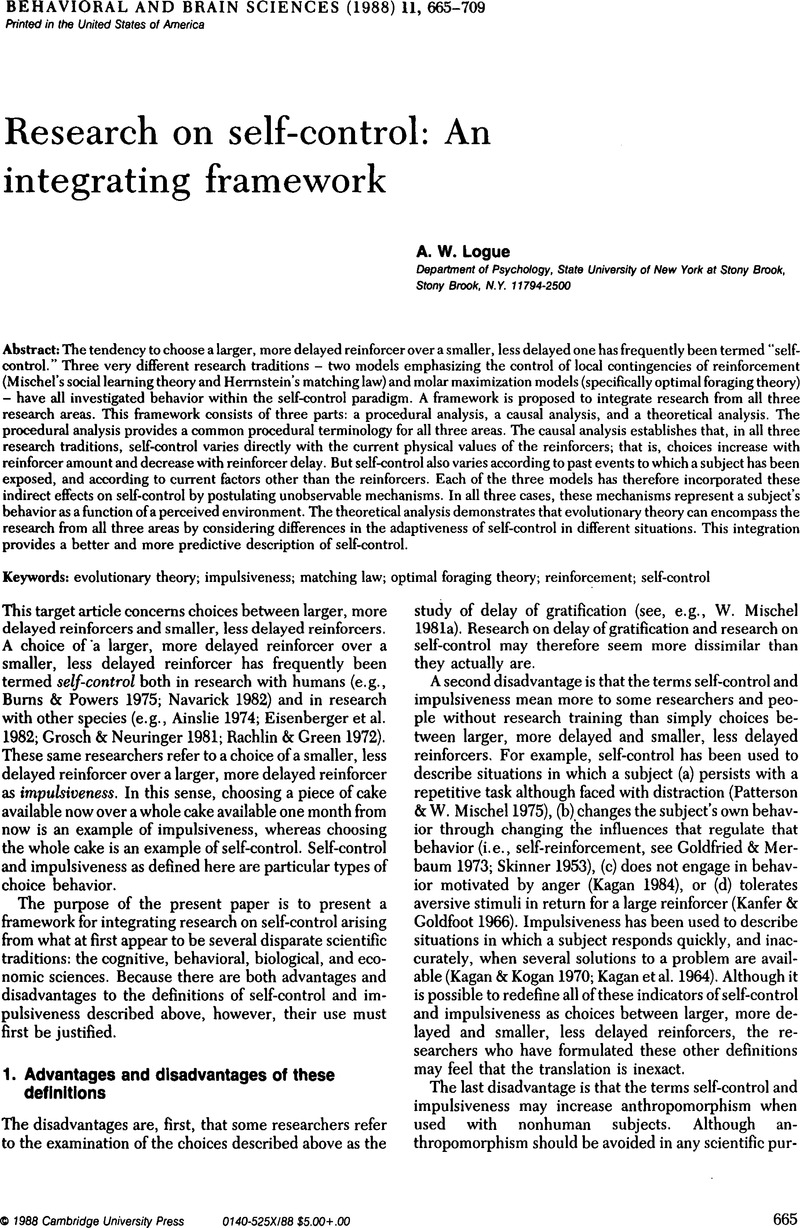Crossref Citations
This article has been cited by the following publications. This list is generated based on data provided by Crossref.
Logue, A.W.
and
King, George R.
1991.
Self-control and impulsiveness in adult humans when food is the reinforcer.
Appetite,
Vol. 17,
Issue. 2,
p.
105.
Mosterin, Jesus
1995.
Overcoming addiction through abstract patterns.
Behavioral and Brain Sciences,
Vol. 18,
Issue. 1,
p.
137.
Kane, Robert
1995.
Patterns, acts, and self-control: Rachlin's theory.
Behavioral and Brain Sciences,
Vol. 18,
Issue. 1,
p.
131.
Tonneau, François
1995.
Further choices for molar theory.
Behavioral and Brain Sciences,
Vol. 18,
Issue. 1,
p.
145.
Baum, William M.
1995.
Patterns yes, agency no.
Behavioral and Brain Sciences,
Vol. 18,
Issue. 1,
p.
122.
Fantino, Edmund
1995.
The future is uncertain: Eat dessert first.
Behavioral and Brain Sciences,
Vol. 18,
Issue. 1,
p.
125.
Hineline, Philip N.
1995.
The extended psychological present.
Behavioral and Brain Sciences,
Vol. 18,
Issue. 1,
p.
128.
Schirillo, James A.
1995.
Self-control: Acts of free will.
Behavioral and Brain Sciences,
Vol. 18,
Issue. 1,
p.
141.
Zentall, Thomas R.
1995.
The cost of an interrupted response pattern.
Behavioral and Brain Sciences,
Vol. 18,
Issue. 1,
p.
147.
Hocutt, Max
1995.
Self-control as habit.
Behavioral and Brain Sciences,
Vol. 18,
Issue. 1,
p.
129.
Rachlin, Howard
1995.
Self-control: Beyond commitment.
Behavioral and Brain Sciences,
Vol. 18,
Issue. 1,
p.
109.
Hughes, Jordan
and
Churchland, Patricia S.
1995.
My behavior made me do it: The uncaused cause of teleological behaviorism.
Behavioral and Brain Sciences,
Vol. 18,
Issue. 1,
p.
130.
Lacey, Hugh
1995.
Teleological behaviorism and the intentional scheme.
Behavioral and Brain Sciences,
Vol. 18,
Issue. 1,
p.
134.
Mele, Alfred
1995.
Conceptualizing self-control.
Behavioral and Brain Sciences,
Vol. 18,
Issue. 1,
p.
136.
Premack, David
and
Premack, Ann James
1995.
Why self-control is both difficult and difficult to explicate.
Behavioral and Brain Sciences,
Vol. 18,
Issue. 1,
p.
140.
Logue, A. W.
1995.
Form, function, and self-control.
Behavioral and Brain Sciences,
Vol. 18,
Issue. 1,
p.
136.
Branch, Marc N.
1995.
When is a pattern a pattern?.
Behavioral and Brain Sciences,
Vol. 18,
Issue. 1,
p.
123.
Kanekar, Suresh
1995.
Conceptual problems in the act-versus-pattern analysis of self-control.
Behavioral and Brain Sciences,
Vol. 18,
Issue. 1,
p.
132.
Summers, Craig
1995.
The role of discounting in global social issues.
Behavioral and Brain Sciences,
Vol. 18,
Issue. 1,
p.
144.
Killeen, Peter R.
1995.
The future of an illusion: Self and its control.
Behavioral and Brain Sciences,
Vol. 18,
Issue. 1,
p.
133.



